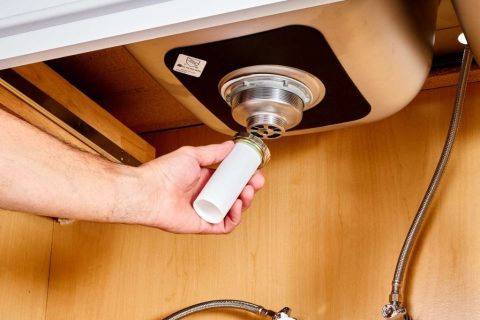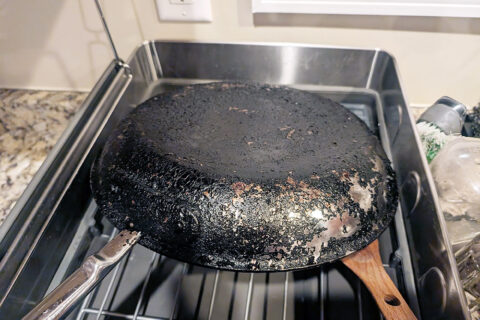
Handwashing dishes might not be the most exciting chore, but it’s essential! Whether you don’t have a dishwasher or just need to clean a few items quickly, knowing how to do it right can save you time and keep your kitchen clean.
Hand-washing dishes also helps you take better care of your favorite plates, cups, and pans, especially the ones that can’t go in a dishwasher.
In this guide, we’ll cover everything you need to know from what supplies to grab to the best way to wash, rinse, and dry your dishes.
Let’s dive in and get those dishes sparkling clean!
Jump to Section [Hide]
Gather Your Dishwashing Essentials
Start by collecting everything you need to clean your dishes effectively. Having the right supplies can make the process faster and easier.
Dish soap
Dish soap is your primary tool for dishwashing. Go for plant-powered options like ECOS or Archipelago’s Natural Dish Soap. They clean well, are biodegradable, and are safe for the skin. Grapefruit dish soap also works great and keeps your hands soft.
Choose a liquid that cuts through grease quickly. Avoid harsh soaps that dry out your skin or harm the environment. A little goes a long way just add a small squirt of hot water to your sink or wash basin!
Scrubbing tools
Scrubbing tools make cleaning faster and easier. Use non-abrasive sponges for everyday dishes, but replace them every two weeks to avoid bacteria buildup. Scouring pads or steel wool are great for tough jobs like cast iron skillets, but check that they don’t scratch your crockery or flatware.
Pick bristly dish brushes for reusable items such as metal straws or bottles like Nalgenes. Keep a mix of scrubbing tools close by to handle different tasks easily. Always rinse the tool afterward to keep it clean and ready for next time!
Dish rack or drying towels
Use a dish rack to save time. It lets dishes air-dry after washing, and you don’t need extra effort. Place a towel underneath to catch dripping water, keeping your counter dry and clean.
Reusable towels are eco-friendly compared to paper ones. Use them for drying when you have fewer utensils or silverware. Rotate clean towels often to avoid germs or bad smells forming on them.
Optional tools
Rubber gloves keep your hands safe from drying soap and harsh cleaning products. They also let you handle hot water with ease. If you don’t have a two-basin sink, use a plastic tub for rinsing dishes.
It saves water and helps rinse things faster. You could also use dishwashing mats to prevent scratches on fragile items like plates or glasses.
The Step-by-Step Dishwashing Process
Follow these easy steps to make hand-washing dishes quick and stress-free!
Step 1: Scrape off leftover food and Organize dishes by type
Clear the sink first to make space. Use a spatula, food scraper, or paper towel to scrape off leftover food from dishes. Removing debris now saves you from scrubbing later and keeps water cleaner.
Sort dishes by type: plates, glasses, silverware, and cutting boards. This helps you wash faster and prevents fragile items like glassware from breaking into the pile.
Step 2: Fill the sink or basin with hot, soapy water
Fill one basin with hot water and dish soap. The heat cuts through grease, while the soap helps break down food residue. Use enough washing-up liquid to create bubbles.
If using two basins, prepare another with cool, clean water for rinsing. Replace rinse water as it gets dirty. This method saves time and keeps dishes spotless!
Step 3: Soak dishes with heavy residue
Place dishes with stuck-on food in hot, soapy water. Let them soak for 15–30 minutes to loosen the residue.
Avoid soaking cast iron, as it can rust. This step makes scrubbing easier and saves effort later. Use a separate basin if needed for large items like pans or pots.
Step 4: Wash items in order
Start with the least dirty items, like glasses and cups. These are usually quick to clean and keep your water from getting dirty too fast. Next, move on to plates and bowls.
Save greasy pots, pans, or cooking tools for last. This keeps oil and heavy grime away from other dishes. Washing in this order helps you work faster and keeps things hygienic!
Step 5: Scrub each item thoroughly
Use a scrubber or sponge to clean each dish. Focus on food spots and greasy areas. Apply enough pressure to remove stuck residue. Scrub in small circles for tough spots, like baked-on cheese or sauces.
Tackle one item at a time. Wash glasses first, then the less dirty plates and utensils. Save oily pots for last. This keeps your water cleaner longer! Make sure every surface feels smooth before rinsing.
Step 6: Rinse with clean, hot water
Rinse each dish with hot water to wash away the soap. Ensure no suds remain, as leftover soap can leave spots or streaks. Hot water also helps kill germs for extra sanitization.
Spray plates, glasses, and silverware one at a time under hot water. If you have a dishwasher nozzle, use it for thorough rinsing. To keep items clean, place them on a drying rack right after rinsing.
Step 7: Place items on a drying rack or towel
Set clean dishes on a drying rack. This allows air to dry them naturally. For items like glasses or metal, lay them on a towel instead. This helps avoid water spots.
If hard water leaves marks, mix vinegar with rinse water before drying. While placing each dish down neatly, check for any missed soap or residue.
Drying and Putting Away
Drying dishes helps avoid water spots and keeps them clean. Store them neatly to save space and protect fragile items.
Air-drying vs. towel-drying
Place clean dishes on a drying rack for air drying. This method avoids spreading bacteria from towels and works best for plates, bowls, and utensils. Make sure the rack allows airflow to prevent stale smells.
Use clean hand towels for towel-drying if you want to finish faster. Buff glassware and metal items like knives or pans to avoid water spots. Replace wet towels often to keep things hygienic.
Preventing water spots
Use vinegar in rinse water to fight water spots. Add a splash of white vinegar to the final rinse for shiny, spot-free dishes. It helps cut through hard water minerals.
Dry dishes quickly to avoid streaks. Use a clean towel or drying rack for faster air drying. Wipe your sink and tools after washing to keep everything neat and ready for the next use.
Storing dishes properly
Stack plates neatly in cabinets to avoid chipping. Place heavier dishes on lower shelves for safety. Use a drying rack for air-drying; it helps prevent dampness and speeds up the process.
Dry glasses with a towel to prevent water spots. Avoid paper towels, as they create waste. Store bowls upside down to keep them dust-free. Wipe the sink after putting away dishes to keep your kitchen clean!
Common Mistakes to Avoid
Avoid these common slip-ups… they can make dishwashing harder than necessary!
Using cold water
Cold water works best for cleaning dairy or starch residue. Hot water can cause these to gum up and stick, making them harder to clean. If plates have leftover cheese, milk, rice, or pasta, rinse them with cold water first.
Switch back to hot water after rinsing for more sanitization. This step helps kill germs and leaves your dishes cleaner. Always balance using cold and hot water based on the type of residue you’re dealing with.
Washing knives or wooden utensils improperly
Never soak wooden utensils for too long. This causes them to crack or warp. Wash them quickly with warm, soapy water, and avoid abrasive pads. Dry them right away to keep their shape.
Clean knives immediately after use. This stops rust and keeps them sharp. Don’t use scouring tools that can scratch the blade. Always dry knives by hand before storing to prevent damage.
Letting dishes sit too long
Leaving dishes too long makes food dry and sticky. Hardened bits need more scrubbing and water to clean.
Soak them first in hot water for 15–30 minutes. This softens debris, saving effort later. Avoid turning simple washing into a challenging task!
Not replacing dirty dishwater
A dirty dishwasher loses its effectiveness over time. Grease, food bits, and soap scum accumulate quickly, and instead of cleaning your plates, the dishwasher simply spreads the grime around. Replace the dishwasher often, especially if you’re washing numerous items or handling very greasy dishes.
Use clean water to prevent bacteria from spreading. Hot, soapy water works best for breaking down grease and killing germs. Keep a second basin with cool rinse water nearby and change it when it becomes cloudy.
Freshwater cleans more effectively and ensures no unpleasant smells linger on your dishes!
The Bottom Line
Washing dishes by hand can be simple and calming. Start with the right tools and follow a straightforward process.
Use warm water, good soap, and eco-friendly items for best results. Clean dishes help your kitchen stay fresh and organized.
Take small steps, every clean dish makes a difference!
Additional reading:








